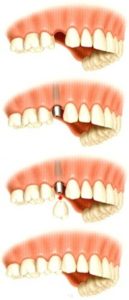Overview
Cosmetic Dentistry
Gum Recession
Root Canal Treatment
Oral Surgeries
Periodontal Therapy
Implants
Children Dentistry
Crowns and Bridges
preventative dentistry
Any Questions
03 9874 0000
Implants
Top Quality Dental Implants Melbourne
What are Dental Implants?
Dental Implants are artificial teeth that are used in place of teeth that never developed, are lost, or extracted. While some would categorise it as cosmetic dentistry, it also has its role in restoration and therapeutic dentistry.
Dental implants are a great way to replace missing teeth and also provide a fixed solution to having removable partial or complete dentures. Implants provide excellent support and stability for these dental appliances.
Dental implants replace the tooth root with an artificial root that is surgically placed into the upper or lower jaw bone by a dentist. The tooth (usually titanium) is attached to artificial root implants and are very natural looking and often enhance or restore a patient’s smile and function.
Dental implants are very strong, stable, and durable and will last many years, but on occasion, they will have to be re-tightened or replaced due to normal wear.

Replace missing teeth without affecting adjacent teeth
- Resolve joint pain or bite problems caused by teeth shifting into missing tooth space
- Restore a patient’s confident smile
- Restore chewing, speech, and digestion
- Restore or enhance facial tissues
- Support a bridge or denture, making them more secure and comfortable
What does the implant teeth cost?
Implant teeth cost depends on the option of material and lots of other factors, welcome to call us to get your own quote.
What does getting dental implants involve?
The process of getting implants requires a number of visits. X-rays and impressions (moulds) are taken of the jaw and teeth to determine bone, gum tissue, and spacing available for an implant. While the area is numb, the implant will be surgically placed into the bone and allowed to heal and integrate itself onto the bone for up to six months.
Depending on the type of implant, a second surgery may be required in order to place the “post” that will hold the artificial tooth in place. With other implants the post and anchor are already attached and placed at the same time.
After several weeks of healing the artificial teeth are made and fitted to the post portion of the anchor. Because several fittings may be required, this step may take one to two months to complete. After a healing period, the artificial teeth are securely attached to the implant, providing excellent stability and comfort to the patient.
You will receive care instructions when your treatment is completed. Good oral hygiene, eating habits, and regular dental visits will aid in the life of your new implant.

